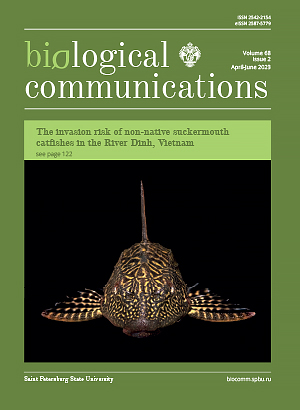Taxonomic diversity and functional potential of microbial communities in salt lakes Gudzhirganskoe and Nukhe-Nur (Barguzin depression, Baikal Rift Zone)
DOI:
https://doi.org/10.21638/spbu03.2023.203Abstract
On the territory of the Barguzin depression (Baikal Rift Zone) there are salt lakes, which are unique natural formations formed in exceptional natural conditions and experiencing extreme shifts in seasonal environmental conditions. This paper presents the results of the study of the microbial communities in the sulfate Lake Gudzhirganskoe and the soda Lake Nukhe-Nur in winter and summer seasons: from the assessment of the taxonomic composition to potential metabolic pathways. For the first time, based on the 16S rRNA gene sequencing data, the diversity of the microbial community of bottom sediments in summer and winter was studied. Environmental conditions such as pH, temperature and mineralization mainly determined the microbial community composition and led to noticeable shifts in the composition of the community at the level of families and genera. The change of the "summer" obligate and moderately alkalphilic and halophilic community to the "winter" alkali-, halotolerant/halophilic microbial community is observed in the winter period in Lake Gudzhirganskoe. In Lake Nukhe-Nur, a change from mesophilic-thermophilic community in summer to mesophilic-psychrophilic microbial community in winter was revealed. The totality of the obtained results gives an idea about the main trends in the seasonal dynamics of extremophilic microbial communities in the studied lakes in response to fluctuations in environmental parameters. The prediction of the metabolic pathways of prokaryotic communities using the Tax4Fun program made it possible to reveal similarities and differences in the metabolic potential of the microbial communities of the studied lakes. Potential functional genes have been found for all stages of the C, N and S cycles, with the exception of nitrification and aerobic CH4 oxidation. Only small qualitative and quantitative variations in the relative abundance of predicted functional genes were found between the microbial communities of the studied lakes. We predicted metabolic pathways that play an important role in the adaptation of microorganisms to changing environmental conditions. In general, it has been shown that there is a change in the dominant taxa at the level of families and genera in the microbial community in the summer and winter seasons, however, the predicted functional potential of microbial communities differed slightly by season and between the studied lakes.
Keywords:
extremophilic microbial communities, taxonomic diversity, seasonal dynamics, functional potential prediction, C, N and S cycles, salt lakes, Baikal Rift Zone
Downloads
References
Downloads
Additional Files
Published
How to Cite
License
Articles of Biological Communications are open access distributed under the terms of the License Agreement with Saint Petersburg State University, which permits to the authors unrestricted distribution and self-archiving free of charge.





